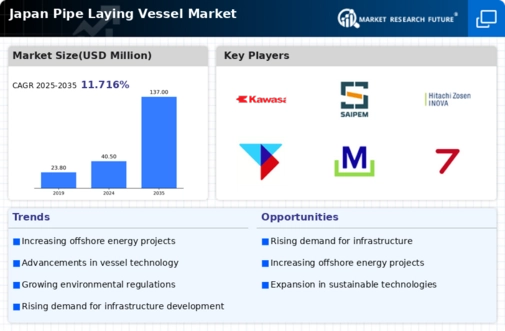Rising Environmental Regulations
Japan's stringent environmental regulations are shaping the pipe laying-vessel market, as companies must comply with new standards aimed at minimizing ecological impact. The government has implemented regulations that require the use of environmentally friendly materials and practices in pipeline construction. This regulatory landscape is pushing companies to invest in modern vessels that meet these requirements, thereby driving demand in the pipe laying-vessel market. As firms adapt to these regulations, the market is expected to see a shift towards vessels that incorporate sustainable technologies, potentially increasing market value by 10-15% over the next few years.
Increasing Offshore Energy Demand
The demand for offshore energy sources, particularly in Japan, is on the rise, driven by the need for sustainable energy solutions. The government has set ambitious targets for renewable energy, aiming for 36-38% of total energy generation from renewables by 2030. This shift necessitates the expansion of infrastructure, including the deployment of pipe laying-vessels for offshore wind farms and other energy projects. The pipe laying-vessel market is likely to benefit from this trend, as these vessels are essential for the installation of underwater pipelines that connect energy sources to the grid. As Japan invests heavily in offshore energy, the market for pipe laying-vessels is expected to grow significantly, potentially reaching a valuation of $1 billion by 2027.
Infrastructure Development Initiatives
Japan's government has initiated several infrastructure development projects aimed at enhancing the country's energy and transportation networks. These initiatives include the construction of new pipelines for gas and oil, which are crucial for energy security. The pipe laying-vessel market is poised to gain from these developments, as specialized vessels are required for the efficient installation of these pipelines. With an estimated investment of ¥10 trillion ($90 billion) in infrastructure over the next decade, the demand for pipe laying-vessels is projected to increase. This growth is further supported by the need for modernization of existing infrastructure, which often requires the replacement or upgrading of old pipelines.
Technological Innovations in Vessel Design
The pipe laying-vessel market is experiencing a wave of technological innovations that enhance operational efficiency and reduce environmental impact. Advanced vessel designs, equipped with state-of-the-art positioning systems and automated laying techniques, are becoming increasingly prevalent. These innovations not only improve the speed and accuracy of pipeline installation but also align with Japan's commitment to reducing carbon emissions. As the industry adopts these cutting-edge technologies, the market for pipe laying-vessels is likely to expand, with projections indicating a growth rate of 5-7% annually over the next five years. This trend suggests a shift towards more efficient and environmentally friendly operations within the market.
Growing Investment in Renewable Energy Projects
The Japanese government is significantly increasing its investment in renewable energy projects, particularly in offshore wind and solar energy. This focus on renewables is expected to create a robust demand for pipe laying-vessels, which are essential for the installation of underwater cables and pipelines that connect renewable energy sources to the grid. With a projected investment of ¥2 trillion ($18 billion) in offshore wind projects by 2030, the pipe laying-vessel market is likely to experience substantial growth. This investment not only supports Japan's energy transition but also positions the market for long-term expansion as the country seeks to enhance its energy independence.




















Leave a Comment